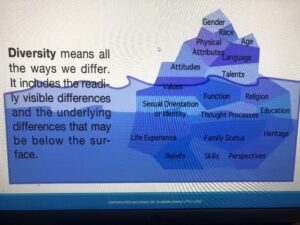By R.V. Baugus
As Sharoni Denise Little, Ph.D., Ed.D., and Nick Schact pointed out in their highly anticipated session on Leading from the Top: Building an Inclusive Venue Culture, it is impossible for an organization to be at peak effectiveness if in fact that leadership in diversity, equity, and inclusivity does not begin with the very top in the chain of command. It is not enough for mid-management to build such an inviting culture, something every venue and its top management should take heed.
“It is very important to recognize as leaders when we think about diversity, equity, or inclusion, what exactly are we  seeking to accomplish?” said Little, who serves as Vice Dean/Senior Diversity, Equity, and Inclusion Officer Professor, Clinical Business Communication at the University of Southern California in addition to being CEO of The Strategist Company. “As executives, we have to look at how we monetize everything we do and recognize if there is a cost benefit analysis of ensuring that every member in our organization is getting to experience to the fullest because we know that the converse might be lower productivity, demotivation, harm to the culture, and that definitely is a risk when we look at risk management.”
seeking to accomplish?” said Little, who serves as Vice Dean/Senior Diversity, Equity, and Inclusion Officer Professor, Clinical Business Communication at the University of Southern California in addition to being CEO of The Strategist Company. “As executives, we have to look at how we monetize everything we do and recognize if there is a cost benefit analysis of ensuring that every member in our organization is getting to experience to the fullest because we know that the converse might be lower productivity, demotivation, harm to the culture, and that definitely is a risk when we look at risk management.”
So, what should that positive experience look like?
“If we are seeking belong where I know that I can come to a space and do my job and that I am connected to the organization and the people in it, I can contribute and not look at any barriers or limitations,” Little said. “But, there has to be evidence of the benefits of it throughout the organization in terms of policies and practices of the leadership. To really understand these concepts first-hand, we are not saying it’s a one size fits all. We cannot create our organizations to be only adapted for leaders or for particular departments, but how are we creating spaces that meet people where they are?”
With a rapt VenueConnect audience that reached 220, it was a session that certainly had the attention of attendees.
“If people don’t feel they have the three factors of survival, safety and security, and social, they can’t think about what the needs of the business are,” said Schact, Chief Global Development Officer for Society for Human Resources Management, in an analogy he related to Pavlovian conditioning. “In leadership roles, we have to model this to be effective. We can’t turn this over to somebody. You can say, I’ve got a chief diversity officer or a diversity and inclusion council to handle all of that. If your behavior doesn’t speak to this inclusive presence that is valuing the diverse population teams we have in our organization, then no one is going to pay any attention to what you say or what they think you are saying. They’re just going to follow the example that you create. Diversity alone doesn’t cut it. Diversity alone is just a numbers game although it is a necessary first step. If we don’t do the rest of it, we don’t get anything else done.”
Moderator Cynthia Tucker, vice chair of the IAVM Diversity & Inclusive Leadership Committee and Assistant Director of Event Operations, University of Southern California – Trojan Event Services, posed the question of why should venue managers have diversity as a core priority, or one of the core priorities.
“Venue comprise spaces and places where our customers can come for purpose,” Little responded. “When they come, from an external perspective they are wanting to not only enjoy the experience but they want to see a reflection of who they are. When we think about being thoughtful, intentional, and strategic about the type of experience we want consumers to have, we have to reflect that in our strategy and our planning. So, as venue managers it’s important that we say why this should be at the forefront when you think about, for example, the type and ways in which we make decisions in terms of composition, in terms of setup, in terms of how we meet them. They are coming to us with an intentional objective.”
Tucker shared that in a poll involving IAVM members that 58% have an EI plan while 42% do not. Asked to address some steps the lower number group could take to formulate a plan, Schact said, “Start by getting executive buy-in. It has to come from the top.”
“Anybody can put together a plan,” he added. “A plan is just writing stuff down on a piece of paper. But if you don’t have commitments to the plan, you won’t move past this very first thing.”
After that, Schact said it is possible to focus on the specific issues needing to be solved.
“It may be representational,” he said. “Do we have diverse representation in our population? If we do, the question then becomes one more of equity. Is there equitable representation across the organization? Do the diverse populations actually feel included?”
The two experts went on to discuss a myriad number of topics related to the session title that by the end of the panel presentation should needle that 42% up.
